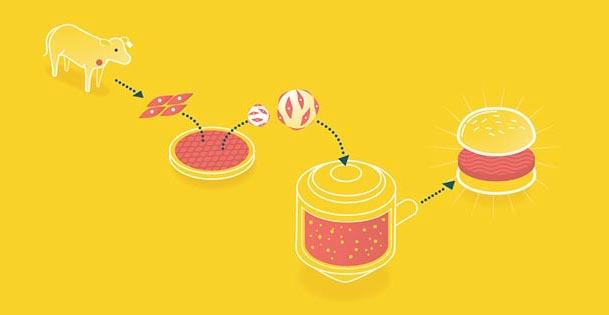https://www.instagram.com/p/BBDOZGFksAt/
New Harvest wants “cellular agriculture,” to be as viable a career option for scientists as molecular biology. Founded in 2004 and based in Manhattan, the nonprofit envisions “a resilient, vibrant, post-animal bioeconomy … where we harvest animal products from cultures, not animals.” Yes, we have a lot of questions, too.
New Harvest will join us as a partner for our upcoming Food Loves Tech conference (tickets on sale now!) scheduled for June 10–12. Curious about this seemingly brave new food future, we reached out to CEO Isha Datar to learn more about the nonprofit’s origins and ongoing work.
Edible Manhattan: Cellular agriculture isn’t something you hear about very often. Where’d you get the idea?
Isha Datar: We started 12 years ago after our founder, Jason Matheny (who currently serves as the director of Intelligence Advanced Research Projects Activity), spent time in India researching infectious diseases. A tour of a poultry farm outside Delhi inspired him to find new ways to meet our global demand for meat.
Once he got back to the States, he began research on a NASA-funded project in which they “grew” goldfish meat to supply astronauts with food on long-range missions. Jason, after contacting the authors who worked on this project, hypothesized that meat could be cultured in the same way, on a larger scale, and that is how New Harvest was born. We are establishing a new field of research called “cellular agriculture,” which is the application of advances in tissue engineering and cell cultures to growing food, namely animal products.
EM: What are the recent trends you’re seeing in agriculture, and how do you see them relating to your work?
ID: When talking about animal farming, we actually see an increase in meat consumption. The growing middle class of China and India increases the demand of meat. With over a billion people in these countries, we expect an increase in meat consumption over the coming decade. Given that only 5 to 6 percent of Americans and 30 percent of Indians follow a vegetarian diet, by our calculations, it seems unlikely that an animal friendly, sustainable method of raising meat (outside of cellular agriculture) is a viable option right now.
https://www.instagram.com/p/BCYqD8FksAZ/
EM: Are you finding a lot of interest in this field among scientists?
ID: No government or academic institute is currently funding this type of research, so it’s an exciting and vast space to pioneer. Eventually, we hope that this field of study will become a widely accepted discipline that scientists can formally contribute to in an academic setting, and pursue careers in.
For scientists, the idea of applying tissue engineering to food production is generally not seen as far-fetched. There are many who would like to conduct research in the area but lack opportunities at present because cellular agriculture has yet to be established as an academic discipline—something that falls under high-priority activities that we are currently working on.
EM: What are the biggest challenges New Harvest and the scientists it supports face?
ID: Funding! It’s exciting being in such an untouched area because there is a lot of opportunity. But it also means, as a nonprofit, funding for this research is hard to come by. All of our operations and grants thus far have been funded by donations.
And while funding is crucial to our mission, overcoming the many public misconceptions associated with cultured foods and the use of science in general (for example the association with GMOs, Monsanto, etc.) is another challenge, and a reason why education is a major focus for us.
https://www.instagram.com/p/BBapq66ksP5/
EM: Could you tell us about some of the projects you’ve supported?
To date New Harvest has launched Muufri, which is creating dairy milk from bioengineered yeast; and Clara Foods, which is creating egg whites from bioengineered yeast. Both companies are early stage start-ups which hope to have their products available within the next few years. They serve a need not just for people wanting to avoid the use of animals for food, but also because of added benefits like being lactose-free (in the case of milk), customization options for different culinary uses (e.g., for yolk-free pasta, or for different baked goods like fluffy angel food cakes) and having longer shelf lives. We have close relationships with all of the other companies in the space as well, such as Pembient (rhino horn), Gelzen (gelatin), Sothic Bioscience (horseshoe crab blood, which is used in medicine) and Modern Meadow (cultured leather and meat) to name a few.
EM: What about the most unique proposal you’ve received so far?
A proposal to create pet food made from plant algae, which is outside of our regular portfolio as it doesn’t involve a molecularly identical replacement of an animal food but rather a plant-based substitution. The objective was to create nutritionally complete plant-based food for dogs and cats.
EM: How will New Harvest make cellular agriculture and the food it produces appealing to the masses?
We believe that being open and transparent about the scientific processes of cellular agriculture is the best way to overcome any “ick” factor that consumers may have with regard to cultured foods. Drawing attention to the many ways in which the current food system is inefficient, unsafe, unhealthy, inhumane, unsustainable, etc., and that cellular agriculture potentially offers solutions to all of these things is another messaging strategy that we think makes the field more appealing to the public as well.



